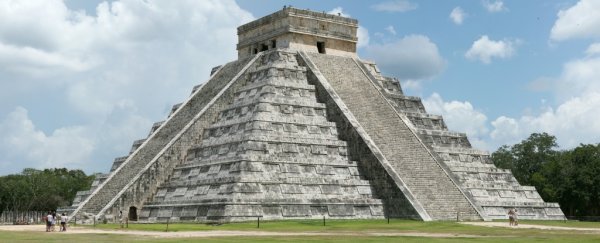The entire Maya civilisation might have gone into decline because of poor water management and an increasing population, scientists have found, using a new mathematical model that simulated the beginning of the end for one of humanity's most influential cultures.
Not only could this model help us understand what happened when the Maya civilisation crumbld in 900 AD - a mystery that researchers have been debating for centuries - it might also help us figure out how to deal with our own water crises in the future.
"Water influences society, and society influences water," said one of the team, Linda Kuil from the Vienna University of Technology in Austria.
"The water supply determines how much food is available, so in turn affects the growth of the population. Conversely, population increases may interfere with the natural water cycle through the construction of reservoirs, for example."
The team's new mathematical model accounted for all the major factors that indicate how well a population is faring, such as population density, birth rate, and food supply, with a particular focus on rainfall and water supply.
Researchers studying socio-hydrology - a field that aims to understand how water supply and management systems affect populations - can use these models to pick and choose different scenarios, experimenting with different conditions and producing different outcomes. Basically, it's a mathematical "What if?" machine.
Since drought is widely considered to have been a major cause of the downfall of the Maya, the team decided to run the particulars of that civilisation through their model.
They started by imputing all of the historically known variables of the Maya civilisation, such as food availability and population density. Then they turned their focus to the possibility of a drought and how the Maya would have handled it.
"It's well-known that the Mayans built water reservoirs in preparation for dry spells," says Kuil. "With our model, we can now analyse the effects of the Mayans' water engineering on their society. It is also possible to simulate scenarios with and without water reservoirs and compare the consequences of such decisions."
Next the team ran calculations to determine what would have happened if these reservoirs were never built. As you can probably guess, without a way to store water during drought, the population slipped. But we know the Maya built reservoirs, andwith these in place in the simulation, the population increased as expected.
But when the team continued their calculations with the reservoirs in place, they found that in the long run, the size of the population would outgrow the reservoirs, leaving the civilisation in a very dire situation when another drought hit.
"The water management behaviour may remain the same, and the water demand per person does not decrease, but the population continues to grow," the team said. "This may then prove fatal if another drought occurs resulting in a decline in population that is more dramatic than without reservoirs."
The researchers say their findings hint at one of the possible reasons for why the Maya civilisation toppled so quickly, though they say much more research is needed before we can know for sure.
Even if the team's findings can't quite put to bed an ancient mystery, the model suggests that patchwork fixes for environmental issues aren't going to solve the world's problems in the long run - something we should heed very carefully today.
"When it comes to scarce resources, the simplest solutions might turn out to be superficial and not always the best ones," Kuil says.
"You have to change people's behaviour, reassess society's dependency on this resource, and reduce consumption - otherwise society may in fact be more vulnerable to catastrophes rather than safer, despite clever technical solutions."
The study was published in Water Resources Research.
